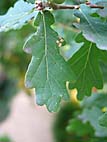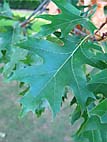The Oak genus (belongs to the Beech-family).
Finding out what Oak species you are dealing with.
Characteristics species are supposed to have according to the books:
- English oak or Quercus robur. This species is the most common in the Netherlands (together with the Red oak). Can be recognized by leafs. The difference with the Sessile oak, which is very alike, lays in the acorns that have a long stem. The leafs of the English oak have a short stem and the leafs have a lobe at the basis.
The trunk is supposed to be rather short and should not go on to high in the tree. The Sessile oak's trunk should, so it is written. In practice I see a lot of oak that have characteristics of both Sessile oak and English oak. Perhaps this has to do with the two species hybridizing.
- Sessile oak or Quercus patrea: rather hard to find. See above.
- Red oak (in Dutch "American oak"). or Quercus rubra. Easily recognized by its leaf-shape. The trunk is more smooth than the native Dutch oaks above. It has a bit of a twist and has horizontal grooves/rings and also vertical light grooving. Is native to America, in the Netherlands planted but now commonly in the wild.
The determination of this species is not hard, although some oak species look alike such as the Scarlet oak (Quercus cocceinea) and Pin oak (Quercus palustris).
- Pin oak (Quercus palustris) and Scalet oak.Two species that are so alike I do not distonguish among them. The pin oak is supposed to have a bit smaller leafs. Both are not seen in the wild, but are always planted. They do not produce young offsping naturally in the Netherlands. Easily recognized by the leafs.
All species photographed.


 Pin oak and Scarlet oak.
Pin oak and Scarlet oak.












